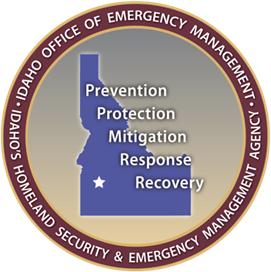- ▾ Other ShakeOuts ▾
- Alaska
- American Samoa
- Arizona
- British Columbia
- California
- Central U.S. (AL AR IA IL IN KS KY LA MO MS NE OH OK TN)
- CNMI
- Colorado
- Guam
- Hawaii
- Idaho
- Japan
- Montana
- Nevada
- New Mexico
- New Zealand
- NorthEast U.S. (CT MA ME NH NJ NY PA RI VT)
- Oregon
- Puerto Rico
- Quebec & Eastern Ontario
- SouthEast U.S. (DC DE FL GA MD NC SC VA WV)
- Texas
- Upper MidWest U.S. (MI MN ND SD WI)
- U.S. Virgin Islands
- Utah
- Washington State
- Wyoming
- Yukon
- Other Countries

Northeast Idaho Earthquake Hazards
|
|
The mountainous area of Idaho north of the Snake River Plain between Yellowstone Park and the Sawtooth Mountains lies within the Central Idaho Seismic Zone (also called the Centennial Tectonic Belt). It is contained within the northern arm of the Yellowstone Tectonic Parabola. The zone is approximately 200 miles long by 50 to 100 miles wide and is characterized by rugged basin and range topography and the highest elevations in Idaho. The zone contains high levels of earthquake activity and at least 6 major active faults (from east to west, Madison, Centennial, Beaverhead, Lemhi, Lost River, and Sawtooth).
Except for portions of the Lost River fault, which ruptured in the Borah Peak earthquake of 1983, the prehistoric earthquake histories of faults in the Central Idaho Seismic Zone are not well known. Much of the research conducted was used to estimate risks posed to the nuclear facilities of the adjacent Idaho National Laboratory. This research shows that ground-rupturing earthquakes larger than magnitude 6 have occurred at least several times over the past 15,000 years along all the active faults. In at least a general way, activity along the faults appears to increase toward the north or northwest, away from the Snake River Plain.
The two largest historical earthquakes in the northern Rocky Mountains occurred in the region on August 17,1959 at Hebgen Lake (magnitude 7.3) and on October 28, 1983 at Borah Peak (magnitude 6.9). Both were accompanied by surface rupture and extensive earthquake aftershocks. The Hebgen Lake earthquake demonstrated the deadly effects of seismically-generated rock falls and landslides in mountainous country. The largest landslide fell into the canyon of the Madison River, killing at least 26 people, and creating a large lake. Three others were killed in the region by falling boulders. The man-made Hebgen Dam narrowly survived overtopping by large water waves (seiche) created by the earthquake.
The Borah Peak earthquake created a spectacular 21 mile-long fault scarp. Other notable effects include water fountains and sand boils, increase or decrease in flow of water in springs, and fluctuations in well water levels. The earthquake caused the deaths of two children in Challis, and an estimated $26.7 million (2008 dollars) in damage in the Challis-Mackay area. Most property damage occurred in Challis and Mackay, where 11 commercial buildings and 39 private houses sustained major damage and 200 houses sustained minor to moderate damage. The Borah Peak earthquake was felt in parts of Montana, Nevada, Oregon, Utah, Washington, Wyoming, and in parts of the provinces of Alberta, British Columbia, and Saskatchewan, Canada.
PARTICIPANTS
people are currently registered to participate in the 2015 ShakeOut Drill.
are from the
Northeast Idaho area
Number of participants in each category
View names of
participants:






